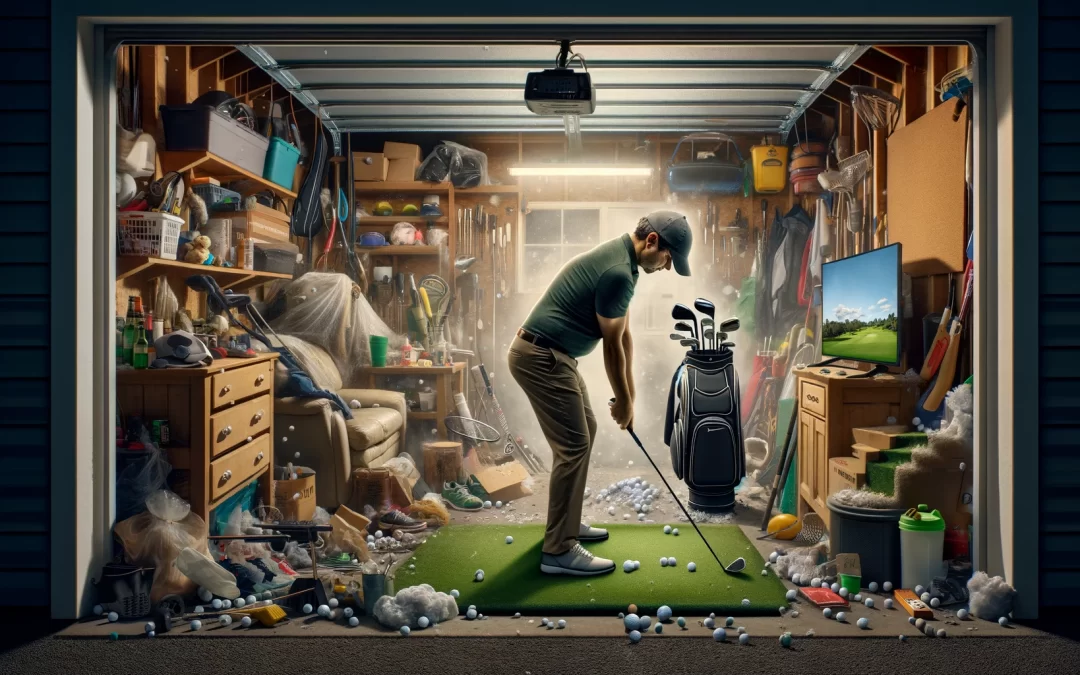Setting up a golf simulator requires careful consideration of the dimensions of your space. To create an immersive and realistic golfing experience, you need to ensure that your room meets the necessary requirements. In this comprehensive guide, I will explore everything you need to know about golf simulator dimensions, including room size, ceiling height, width, and depth.
WHAT'S IN THIS ARTICLE?
Key Takeaways:
Golf simulator dimensions are important for creating a high-quality golf simulation experience.
Consider room size, ceiling height, width, and depth when planning your golf simulator space.
Different types of golf simulators have varying space requirements, so be sure to understand the specific needs of your chosen simulator.
Popular golf simulator brands often have specific space requirements, so research and compare different brands to find the best fit for your space.
Even with a small space, you can still enjoy a golf simulator by optimizing the dimensions and layout.
Also read:
The Ultimate Golf Simulator Man Cave Guide for Beginners
The Importance of Space in Golf Simulator Setup
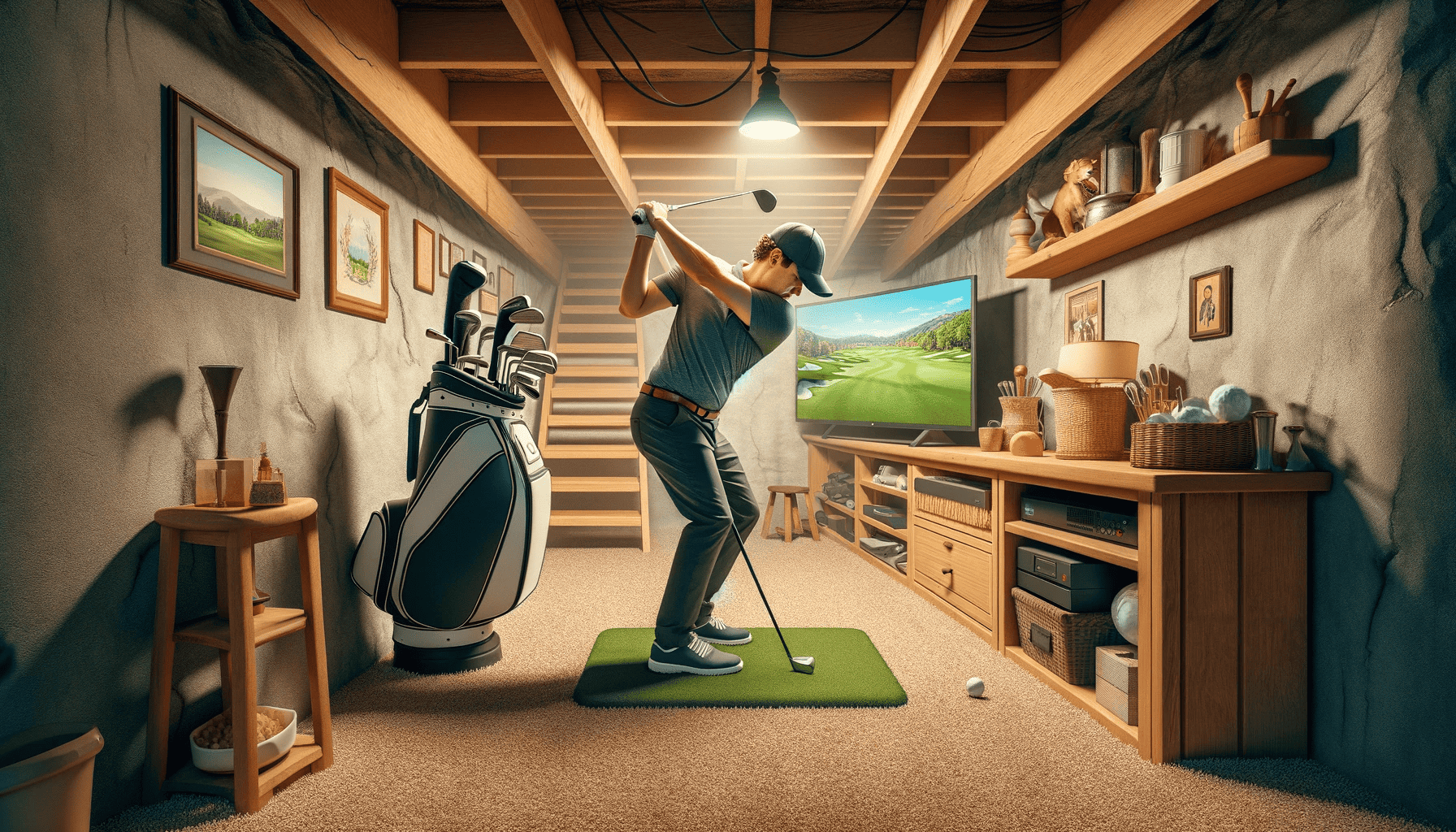
How much space do you need? Sufficient space is crucial for a high-quality golf simulation experience. Having enough room to swing your golf club without restrictions, avoiding obstructions, and accommodating ceiling-mounted launch monitors are important factors to consider.
When setting up your golf simulator, the impact of space on your overall experience cannot be underestimated. With ample space, you can swing freely and confidently, mimicking the feeling of being on a real golf course. However, limited space can lead to restricted movements and less accurate shot analysis.
One of the key reasons why space is important is to provide room for a full golf swing. A proper swing requires adequate space to extend your arms and follow through without hitting any objects or walls. Insufficient space can hinder your ability to generate power and accuracy, compromising the realism and effectiveness of the simulator.
Moreover, having enough space allows for the installation of ceiling-mounted launch monitors. These devices play a vital role in capturing accurate data about your swing, ball speed, and trajectory. Without enough vertical space, you may not be able to mount the launch monitor securely, resulting in compromised data collection and analysis.
Additionally, sufficient space ensures that there are no obstructions between you and the impact screen. A clear path between the tee and the screen is essential for an unhindered shot, allowing the simulator to accurately measure your shot outcomes, such as distance, direction, and ball flight.
By considering the importance of space in your golf simulator setup, you can optimize your experience and maximize the benefits of having a simulator at home or at a commercial facility. The right amount of space provides the freedom to swing without restrictions, accuracy in shot analysis, and an immersive simulation experience.
Is a Golf Simulator too Much Money?
Simulators can range wildly in price. To assemble one yourself, you can probably get the job done for 3-4k. If you want a plug and play simulator, it can be more.
There are two leading retailers of golf simulators in the US. Fortunately, both Rain or Shine Golf and indoor golf shop offer finance so customers can spread the cost over time. Indoor golf shop and Rain or Shine are both trusted, top tier retailers.
The Fundamentals for Golf Simulator Room Dimensions
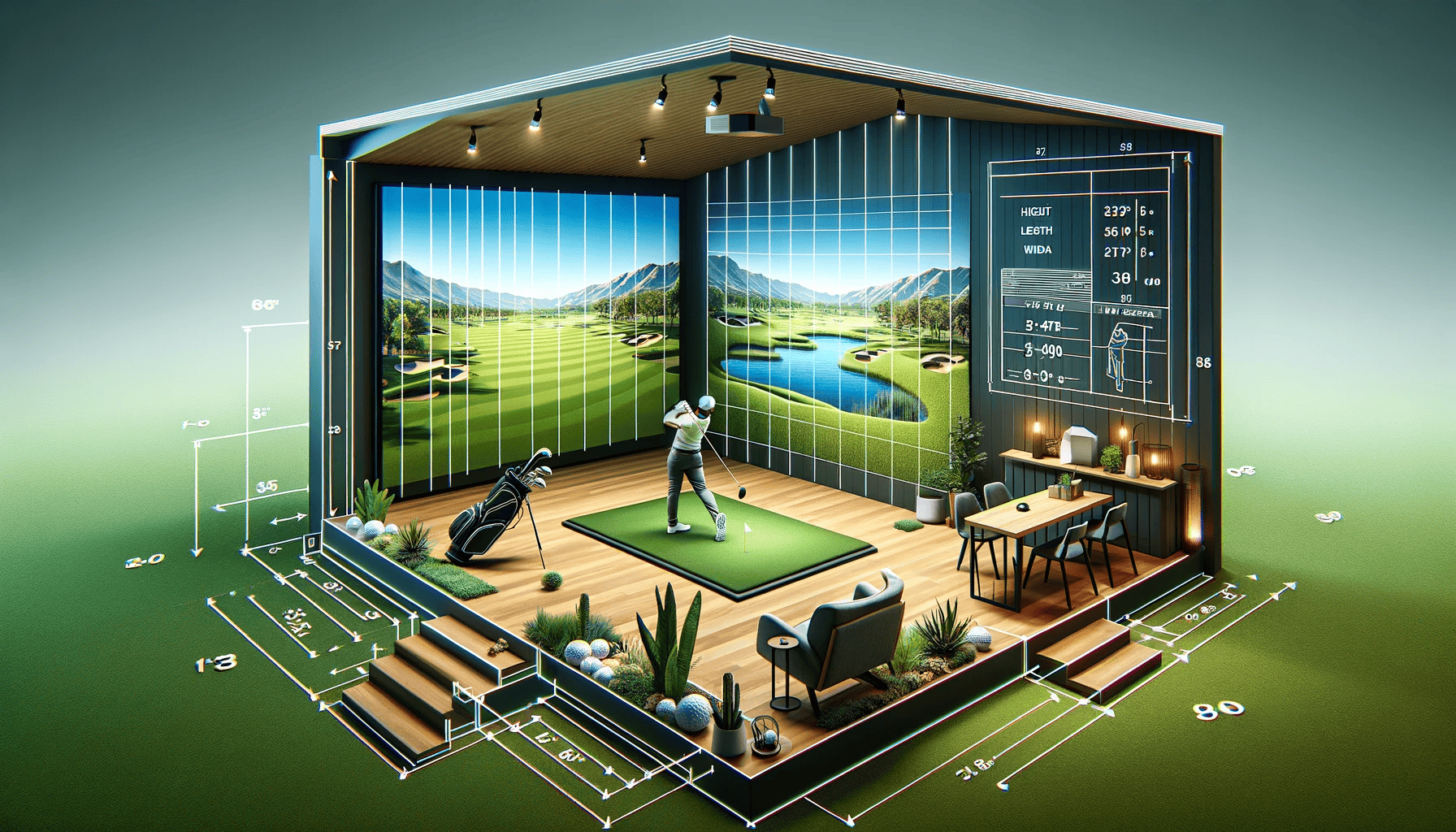
When it comes to setting up a golf simulator, the dimensions of your room are of utmost importance. The length, width, and height of the space can greatly impact the functionality and effectiveness of your golf simulator. In this section, I will provide you with the fundamental dimensions that are necessary for a golf simulator room and discuss how they can enhance your overall golfing experience.
Length:
The length of your golf simulator room is crucial for achieving realistic ball flight and a smooth swing. A sufficient length allows for optimal club and ball tracking, ensuring accurate shot data. It also provides ample space for your swing, preventing any restrictions or hindrances during your practice sessions or virtual rounds. To ensure an immersive experience, it is recommended to have a minimum length of 12 to 15 feet.
Width:
The width of your golf simulator room is essential for accommodating various swing paths and positioning the tee in the center. A wider space enables comfortable swinging for both right- and left-handed players, avoiding any collisions with the walls or surrounding obstacles. Ideally, your golf simulator room should have a minimum width of 10-12 feet, providing ample room for unrestricted swings and accurate shot measurements.
Height:
The height of your golf simulator room directly impacts your swing and the functionality of ceiling-mounted launch monitors. A sufficient ceiling height allows for a full range of motion during your swing, preventing any disruption or discomfort. It also enables you to install an enclosure or net for added safety. For optimal performance and an enjoyable experience, it is recommended to have a minimum ceiling height of 9-10 feet.
| Dimension | Recommended Minimum Value |
|---|---|
| Length | 12 feet |
| Width | 10 feet |
| Height | 9 feet |
By ensuring that your indoor golf simulator room meets these fundamental dimensions, you can enhance the functionality and effectiveness of your golf simulation experience. A well-designed space provides you with the freedom to practice your swing, receive accurate shot data, and immerse yourself in a realistic virtual golfing environment.
How Does Room Height Affect My Golf Simulator Setup?
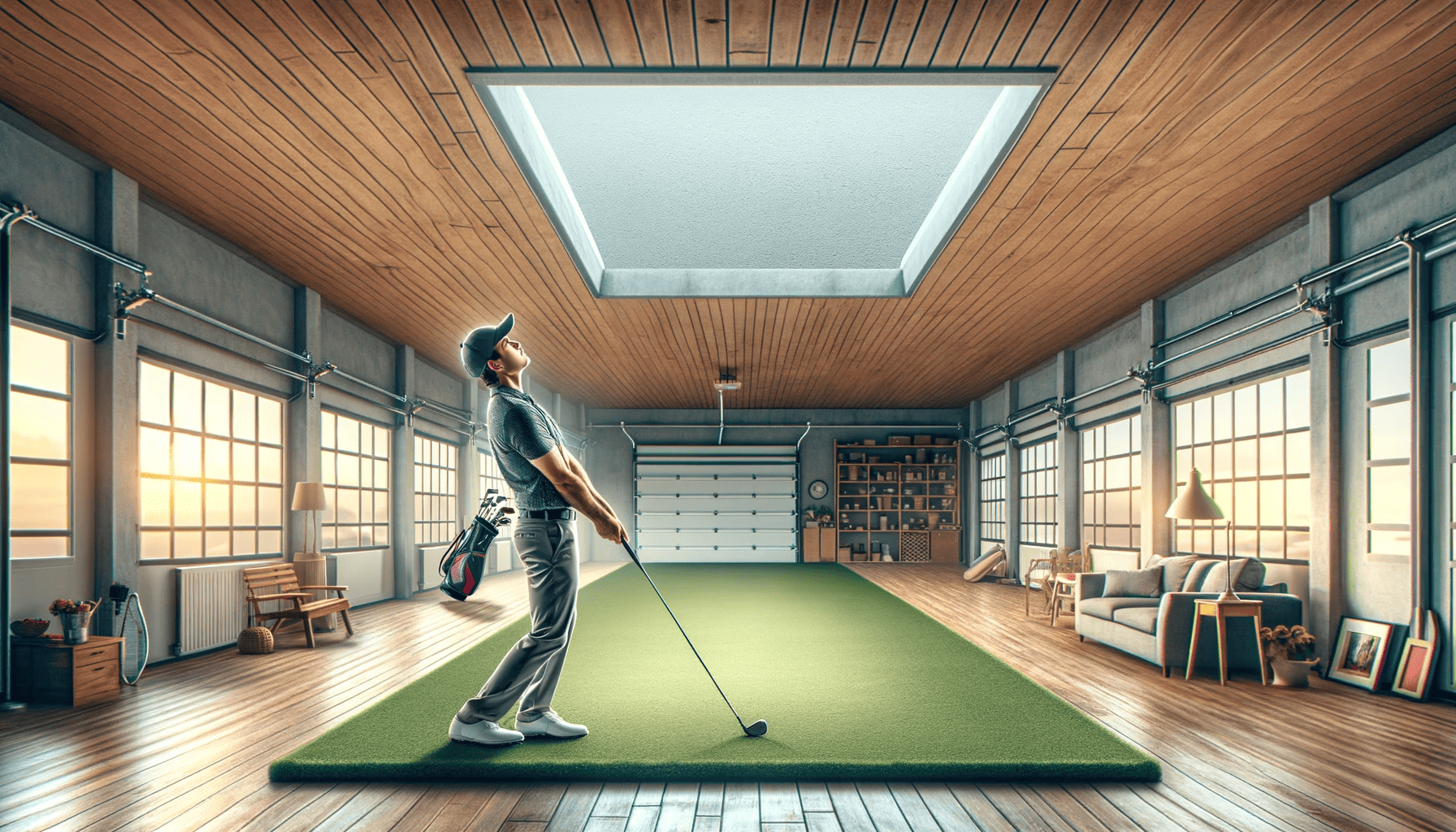
The height of your room is an essential factor to consider when setting up a golf simulator. It has a direct impact on the comfort of your swing, the feasibility of fitting an enclosure or net, and the proper functioning of ceiling-mounted launch monitors. Let’s explore how the room height affects your overall golfing experience.
The Comfort of Your Swing: A sufficient ceiling height ensures that you can swing your club freely without any restrictions. It allows you to fully extend your arms and follow through with your swing, promoting a natural and fluid motion.
Fitting an Enclosure or Net: Depending on the design of your golf simulator, you may need to install an enclosure or a net to capture golf balls and prevent them from causing any damage. A higher room height provides more space for these protective measures, reducing the risk of broken windows or other accidents.
Ceiling-Mounted Launch Monitors: Many golf simulators utilize ceiling-mounted launch monitors to track your swing and provide accurate data on ball flight and distance. These launch monitors need sufficient overhead clearance to function optimally. When the ceiling height is too low, it may interfere with the accuracy of the measurements and potentially affect the overall simulation experience.
To ensure an optimal golf simulator setup, it’s recommended to have a minimum ceiling height of Golf simulator room height feet. This measurement allows for comfortable swinging, proper installation of enclosures or nets, and seamless operation of ceiling-mounted launch monitors.
How Much Room Width Do I Need for a Golf Simulator?
When setting up a golf simulator, it’s crucial to consider the width of your room to ensure comfortable swinging without the risk of hitting the wall. This is especially important if you want to position the tee in the center, accommodating both right- and left-handed players.
To determine the necessary room width, you need to consider the width of your golf swing and create ample space on each side. A general rule of thumb is to add one to two feet on each side of your swing for a safe margin. This will allow you to swing freely without the worry of damaging the room or your equipment.
If you’re unsure about the ideal width for your golf simulator room, it’s recommended to consult the manufacturer’s guidelines or consult with a professional installer. They can provide specific recommendations based on the dimensions of your simulator and your swing characteristics.
Additionally, consider the layout of your golf simulator room. Optimally positioning the tee in the center allows both right- and left-handed players to have an equal experience. This can be achieved by ensuring sufficient width and positioning the tee in a central location.
In summary, you need to have enough room width in your golf simulator setup to accommodate comfortable swinging and avoid hitting the wall. Positioning the tee in the center allows for a balanced experience for both right- and left-handed players. Make sure to consider these factors when planning your golf simulator room size.
| Pros of Adequate Room Width | Cons of Insufficient Room Width |
|---|---|
| – Comfortable swinging – Reduced risk of damaging wall or equipment – Accommodation for both right- and left-handed players – Equal experience for all players | – Potential wall damage – Risk of equipment damage – Restricted swinging motion – Unequal experience for players |
How Much Room Length Does My Golf Simulator Room Need

When setting up your golf simulator room, the length of the space plays a crucial role in the overall experience and realism of your golf simulation. It impacts the trajectory and ball flight, making it an essential consideration for an optimized setup.
An important factor to consider is the distance between the tee and the impact screen. A sufficient distance allows for a realistic ball flight and accurate shot analysis. When the tee and impact screen are too close, the ball may not have enough time to reach its intended trajectory, leading to inaccurate results. On the other hand, if they are too far apart, the ball may lose speed and accuracy before reaching the screen.
Additionally, having additional space behind the impact screen is advantageous. This extra space accommodates any mishits or shots that carry further than expected, preventing damage to the screen and providing a buffer zone for a more realistic experience.
Furthermore, it’s essential to ensure an unobstructed swing within your simulator room. Having obstacles or obstructions in the swing path can negatively affect your swing mechanics and hinder the accuracy of shot analysis.
Optimal Golf Simulator Room Length Guidelines
To help you plan your golf simulator room, here are some general guidelines for the ideal room length based on the distance between the tee and the impact screen:
| Distance Between Tee and Impact Screen | Recommended Room Length |
|---|---|
| 10-15 feet | Minimum of 15 feet |
| 15-20 feet | Minimum of 20 feet |
| 20-25 feet | Minimum of 25 feet |
| 25+ feet | Minimum of 30 feet |
Please note that these are general recommendations, and the specific dimensions may vary depending on the golf simulator system you choose and your personal preferences.
In conclusion, when planning your golf simulator room, ensuring adequate space length is essential for optimal trajectory, ball flight, and swing accuracy. Consider the distance between the tee and impact screen, allocate additional space behind the screen, and maintain an unobstructed swing path for a truly immersive golfing experience.
Space Requirements for Golf Simulators Based on Their Types
When it comes to setting up a golf simulator, understanding the space requirements for different types of simulators is essential for optimal performance. The specific dimensions needed can vary depending on whether you have a photometric, radar-based, or infrared simulator.
Photometric Simulators
Photometric simulators use high-speed cameras and advanced image processing to track the golf ball and club. These simulators require a larger space compared to other types due to their precise tracking capabilities.
| Golf Simulator Type | Space Requirements |
|---|---|
| Photometric Simulator | Minimum room dimensions of 15′ (width) x 20′ (length) x 10′ (height) |
Radar-Based Simulators
Radar-based simulators use Doppler radar technology to track the flight of the ball and clubhead speed. These simulators typically require less space compared to photometric simulators but still require enough room for a comfortable swing.
| Golf Simulator Type | Space Requirements |
|---|---|
| Radar-Based Simulator | Minimum room dimensions of 12′ (width) x 16′ (length) x 10′ (height) |
Infrared Simulators
Infrared simulators use infrared sensors to track the golf ball and provide accurate data. These simulators offer a compact setup and require less space compared to both photometric and radar-based simulators.
| Golf Simulator Type | Space Requirements |
|---|---|
| Infrared Simulator | Minimum room dimensions of 10′ (width) x 12′ (length) x 8′ (height) |
By understanding the specific space requirements for each type of golf simulator, you can ensure that you have enough room to swing comfortably and enjoy optimal performance. Before investing in a simulator, measure your available space and consult the manufacturer’s guidelines to ensure that your setup meets the recommended dimensions.
Space Requirements for Popular Golf Simulator Brand
When it comes to choosing a golf simulator, understanding the space requirements for different brands is crucial. Each brand has specific dimensions that need to be considered to ensure optimal performance and a satisfying golfing experience. Let’s take a closer look at the space requirements for some popular golf simulator brands:
Skytrak
Skytrak, a well-known brand in the golf simulator industry, requires a minimum space of 9 feet (2.74 meters) in height and 12 feet (3.65 meters) in width. The ideal space for a Skytrak simulator is around 10 feet (3.05 meters) high and 15 feet (4.57 meters) wide to allow for comfortable swinging without any obstructions.
Uneekor QED
Uneekor QED simulators typically require a minimum ceiling height of 9.5 feet (2.89 meters) and a width of 12 feet (3.65 meters). For an optimal experience, it is recommended to have a ceiling height of 10 feet (3.05 meters) and a width of 14 feet (4.27 meters) for the Uneekor QED simulator.
TruGolf Vista 8
The TruGolf Vista 8 simulator requires a minimum ceiling height of 10 feet (3.05 meters) and a width of 12 feet (3.65 meters). To enhance the experience, it is recommended to have a ceiling height of 12 feet (3.65 meters) and a width of 15 feet (4.57 meters) for the TruGolf Vista 8 simulator.
Uneekor EYE XO and Uneekor Eye Mini
Both the Uneekor EYE XO and Uneekor Eye Mini simulators have similar space requirements. These simulators typically require a minimum ceiling height of 9.5 feet (2.89 meters) and a width of 12 feet (3.65 meters). For the best results, it is recommended to have a ceiling height of 10 feet (3.05 meters) and a width of 14 feet (4.27 meters) for the Uneekor EYE XO and Uneekor Eye Mini simulators.
Foresight Sports GCHawk, GCQuad, and GC3
The Foresight Sports GCHawk, GCQuad, and GC3 simulators all have similar space requirements. These simulators typically require a minimum height of 9 feet (2.74 meters) and a width of 12 feet (3.65 meters). For optimal performance, it is recommended to have a height of 10 feet (3.05 meters) and a width of 16 feet (4.88 meters) for these Foresight Sports simulators.
FlightScope Mevo+
The FlightScope Mevo+ simulator requires a minimum ceiling height of 10 feet (3.05 meters) and a width of 12 feet (3.65 meters). For a more enjoyable experience, it is recommended to have a ceiling height of 12 feet (3.65 meters) and a width of 15 feet (4.57 meters) for this simulator.
Full Swing Golf Simulator KIT
The Full Swing Golf Simulator KIT typically requires a minimum ceiling height of 9 feet (2.74 meters) and a width of 10 feet (3.05 meters). For a spacious and comfortable setup, it is recommended to have a ceiling height of 10 feet (3.05 meters) and a width of 12 feet (3.65 meters) for this simulator.
Bushnell Launch Pro and Garmin R10 Approach
The Bushnell Launch Pro and Garmin R10 Approach simulators are compact options that require a minimum ceiling height of 9 feet (2.74 meters) and a width of 10 feet (3.05 meters). These simulators are great choices for those with limited space but still want to enjoy a realistic golfing experience.
It’s important to note that these space requirements may vary depending on additional factors such as the type of hitting mat, ball flight, and personal comfort. When setting up your golf simulator, always refer to the specific guidelines provided by the manufacturer to ensure the best results. By considering these space requirements, you’ll be able to choose a golf simulator that fits perfectly into your designated space, allowing you to swing away without any restrictions.
Fitting a Golf Simulator Into a Small Space
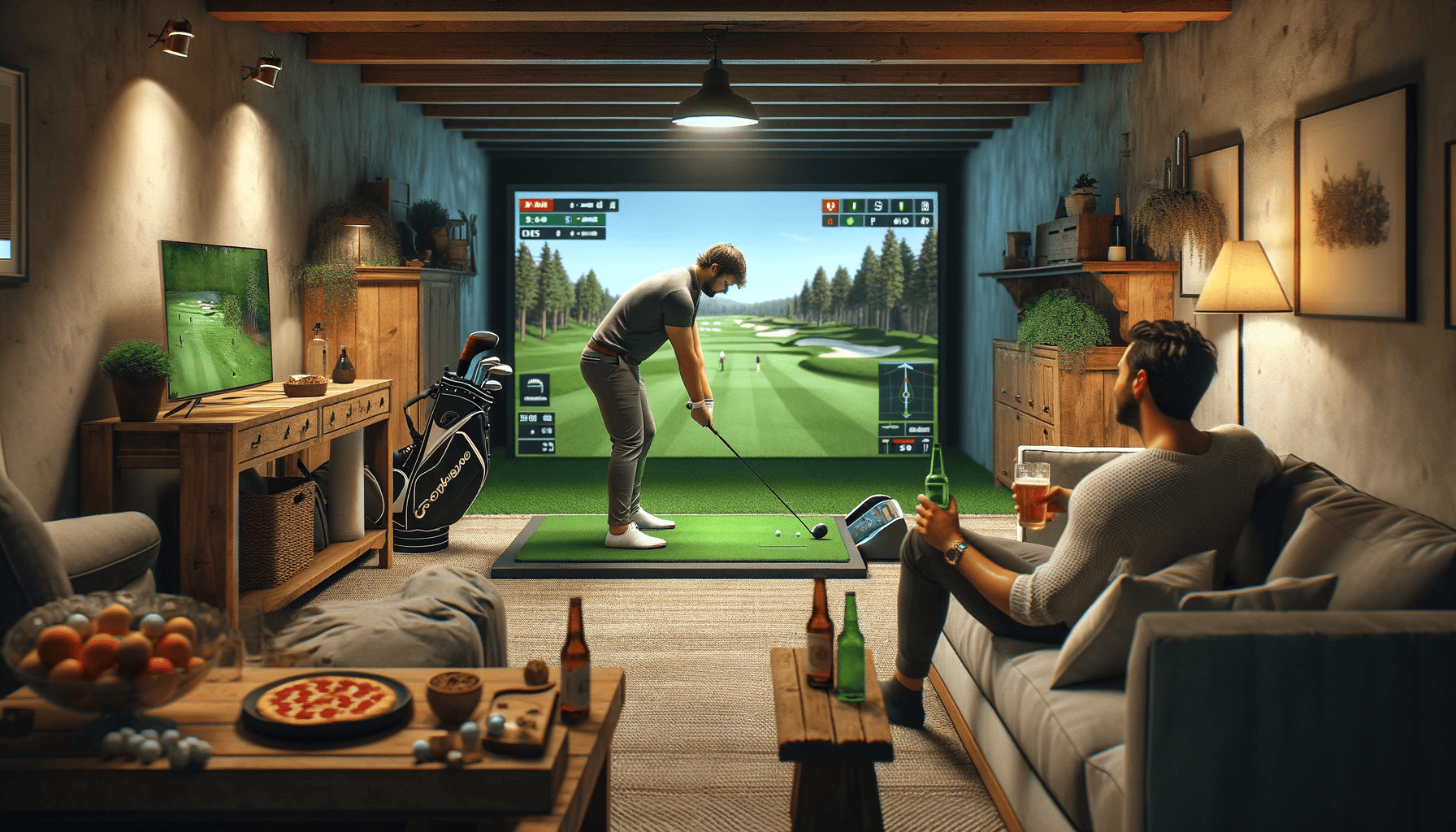
Don’t let a small space hold you back from enjoying a golf simulator. With some clever planning and optimization, you can make the most out of your limited area. Here are some practical tips on how to fit a golf simulator into a small space:
Testing the Space for Comfortable Swinging
Before installing your golf simulator, it’s crucial to ensure you have enough room for comfortable swinging. Take your golf club and practice a few swings within the space to determine if there are any restrictions or obstacles. This will help you evaluate if the area is suitable for a golf simulator setup.
Height Requirements
Check the height of your space to make sure it meets the requirements for your golf simulator. Some simulators may require a minimum ceiling height for accurate measurements and optimal performance. Measure the distance from the floor to the ceiling and cross-reference it with the specifications provided by the simulator manufacturer.
Buffer Space
In a small space, it’s important to create a buffer zone around the hitting area to prevent any accidents or damage. Leave enough space between the hitting area and the surrounding walls or furniture to allow for a safe and uninterrupted swing. This buffer space will also ensure that the simulator components, such as the impact screen or projector, are not at risk of being damaged during your swing.
Swing Space
Consider the swing space required by your golf simulator setup. This includes the arc of your swing as well as the space needed for the simulator’s tracking system to accurately capture your shots. Ensure that there is enough room for a full swing without the risk of hitting any objects or walls.
Offsetting the Hitting Area
If your small space doesn’t allow for a direct hitting area perpendicular to the screen, consider offsetting it slightly. This means angling the hitting area and aligning it diagonally with respect to the impact screen. By offsetting the hitting area, you can create more swing space and optimize the usage of your limited space.
By implementing these strategies, you can fit a golf simulator into a small space without compromising on the quality of your golfing experience. With proper planning and optimization, even the most compact areas can transform into a golfer’s paradise.
Planning Your Space for a Commercial Golf Simulator
When it comes to setting up a commercial space for a golf simulator, careful planning is essential. Whether you’re creating a dedicated golfing venue or integrating a simulator into an existing entertainment facility, there are key factors to consider. From minimum height requirements to accommodating both left-handed and right-handed players, here are some tips to help you plan your space effectively.
Minimum Height Requirements
The first and most important consideration is the minimum height required for your commercial golf simulator. This is crucial to ensure that players can swing their clubs comfortably without any restrictions. Different simulators may have varying height requirements, so it’s essential to check the specifications provided by the manufacturer. By ensuring adequate ceiling height, you can provide a seamless and enjoyable experience for your customers.
Accommodating Lefties and Righties
A commercial golf simulator should be designed to accommodate both left-handed and right-handed players. This means positioning the tee and other essential elements in a way that allows players of all orientations to feel comfortable. By creating a space that caters to both lefties and righties, you can attract a wider range of customers and provide a truly inclusive golfing experience.
Number of Bays Needed
Consider the number of bays you’ll need to meet the demand of your commercial golf simulator facility. This will depend on factors such as the size of your space, projected foot traffic, and the overall capacity you aim to achieve. By carefully assessing these factors, you can determine the optimal number of bays to provide an enjoyable experience for all your customers.
Deeper Bays for Enhanced Realism
Deep bays can enhance the realism of the golfing experience in a commercial simulator. By providing ample space between the player and the impact screen, you create a more immersive environment that closely resembles playing on an actual golf course. Deep bays also allow for room to move around during swings, providing a comfortable and unrestricted experience for players.
Enclosure Wall Wear
One important aspect to consider is the wear and tear that can occur on the enclosure wall behind the impact screen. The impact of golf balls hitting the wall over time can cause damage, so it’s crucial to choose durable materials that can withstand the repetitive impact. Additionally, incorporating protective features such as netting or padding can help extend the lifespan of your enclosure and minimize maintenance costs.
Comparison of Minimum Height Requirements for Popular Golf Simulator Brands
| Golf Simulator Brand | Minimum Height Requirement |
|---|---|
| Skytrak | 8 feet |
| Uneekor QED | 9 feet |
| TruGolf Vista 8 | 10 feet |
| Uneekor EYE XO | 9 feet |
| Uneekor EYE Mini | 8 feet |
| Foresight Sports GCHawk | 9 feet |
| Foresight Sports GCQuad | 10 feet |
| Foresight Sports GC3 | 9 feet |
| FlightScope Mevo+ | 8 feet |
| Full Swing Golf Simulator KIT | 10 feet |
| Bushnell Launch Pro | 8 feet |
| Garmin R10 Approach | 9 feet |
These height requirements are approximate and may vary depending on other factors such as player height and swing dynamics. It’s best to refer to the specific specifications provided by the respective manufacturer to ensure accurate planning and installation.
By carefully considering the minimum height, accommodating left-handed and right-handed players, determining the number of bays needed, incorporating deeper bays, and addressing enclosure wall wear, you can create a commercial golf simulator space that provides customers with an immersive and enjoyable golfing experience.
Conclusion
In conclusion, proper planning of the dimensions for your golf simulator space is crucial in order to create an immersive and realistic golfing experience. By considering the length, width, and height of the room, as well as the specific requirements of your chosen simulator brand, you can ensure optimal performance and enjoyment.
Having sufficient space allows for comfortable swinging without any restrictions and helps avoid obstructions in your swing path. It also enables you to accommodate ceiling-mounted launch monitors and fit an enclosure or net, if desired.
Whether you’re setting up a golf simulator in your own home or in a commercial space, understanding the importance of space planning is key. By carefully designing your golf simulator room and considering the specific requirements of your simulator brand, you can create a setup that provides an engaging and lifelike golf simulation experience.
FAQ
What are the dimensions required for a golf simulator setup?
The dimensions required for a golf simulator setup include the length, width, and height of the room. It is important to have enough space for swinging without restrictions and accommodating ceiling-mounted launch monitors.
How does the height of the room affect a golf simulator setup?
The height of the room affects the comfort of your swing, the ability to fit an enclosure or net, and the proper functioning of ceiling-mounted launch monitors. It is important to consider the ideal ceiling height for your golf simulator setup.
How much room width do I need for a golf simulator?
The width of the golf simulator room is crucial for comfortable swinging, especially if you want to position the tee in the center to cater to both right- and left-handed players. It is important to ensure enough space for swinging without the risk of hitting the wall.
How much room length does my golf simulator room need?
The length of the golf simulator room affects the trajectory and ball flight, as well as the realism of the golf simulation. It is important to consider the optimal length, including the distance between the tee and impact screen, additional space behind the screen, and the importance of an unobstructed swing.
What are the space requirements for different types of golf simulators?
Different types of golf simulators, such as photometric, radar-based, and infrared simulators, have varying space requirements. It is important to know the specific space needed for each type of simulator to ensure optimal performance.
What are the space requirements for popular golf simulator brands?
Popular golf simulator brands such as Skytrak, Uneekor, TruGolf, Foresight Sports, FlightScope, Full Swing, Bushnell, and Garmin have specific space requirements. It is important to consider these requirements when choosing the right simulator for your space.
How can I fit a golf simulator into a small space?
Even with a small space, you can still enjoy a golf simulator. It involves testing the space for comfortable swinging, considering the height requirements, creating buffer space, ensuring enough swing space, and offsetting the hitting area to maximize the available space.
How do I plan my space for a commercial golf simulator?
Planning a commercial space for a golf simulator requires careful consideration of factors such as minimum height, accommodating both lefties and righties, determining the number of bays needed, and understanding the importance of deeper bays and enclosure wall wear.
Sam has been playing golf for over 20 years.
Over the years, he has worked his way through just about every type of equipment on the market. Fortunate to have a close friend that plays professionally, Sam not only tests the latest offerings by the top brands, but gets the inside track on the club tech PGA pros use on tour
Sam understands the needs and intent of equipment brands, professionals and every day golfers. He strives to fill in the gaps.

